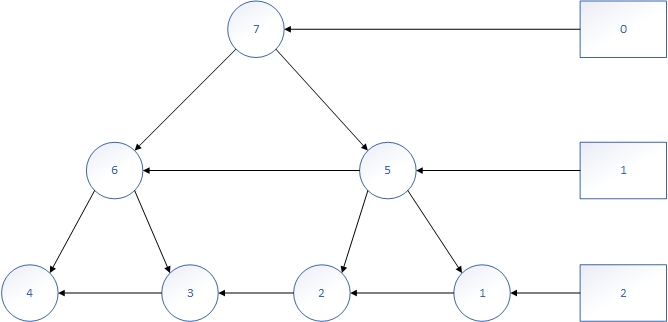标签:str 指针 int 答案 loading pre 堆排序 根据 构建
给定一个非空的整数数组,返回其中出现频率前 *k* 高的元素。
示例 1:
输入: nums = [1,1,1,2,2,3], k = 2
输出: [1,2]
示例 2:
输入: nums = [1], k = 1
输出: [1]
提示:
本题的主要解题过程就是先用一个map保存数字和它出现次数的键值对,然后对这些键值对进行从大到小排序,选出前K个元素就可以了
所以本题的核心就是进行排序,我们在本题采用的排序方法是堆排序,也怪我,前面不知道go源码已经实现了堆排序的库,我们直接调用container/heap这个包就可以了,所以我先自己实现了堆排序,然后又用go语言内置的sort排序实现了一遍,最后采用go内置的堆排序又实现了一遍,所以本题我采用了三种解法
map中的键值对,然后用这些键值对组成一棵完全二叉树k个值,就继续这个循环,然后再次获取我的堆结构如下图所示:

右边的矩形是一个数组,里面每一个元素是一个链表的头结点。链表的作用是用来定位最后一个结点的位置,例如当前最后一个结点是1,当我们将1移动到根结点并且删除原来结点1以后,新的最后一个结点就是2
func topKFrequent2(nums []int, k int) []int {
// 先用一个map来存储数字以及出现的次数
numsMap := make(map[int]int)
for _, num := range nums {
numsMap[num]++
}
// 用这个map构建二叉树,用二叉树实现堆
type node struct {
num int
times int
leftChild *node
rightChild *node
leftLoc *node
parent *node
}
var root *node
var topQue, downQue []*node
var lOrR, newLine bool
var parentNode *node
var levelList []*node
for key, value := range numsMap {
tmpNode := &node{
num: key,
times: value,
}
if root == nil {
// 此时树还是空的
root = tmpNode
topQue = append(topQue, root)
levelList = append(levelList, root)
} else {
// 此时树不是空的,从上层队列出队,下层队列入队
if !newLine {
// 这是新的一层
levelList = append(levelList, tmpNode)
newLine = !newLine
} else {
// 不是新的一层
// 在每一层的链表头加上结点
levelList[len(levelList)-1], tmpNode.leftLoc = tmpNode, levelList[len(levelList)-1]
}
if !lOrR {
parentNode = topQue[0]
topQue = topQue[1:]
parentNode.leftChild = tmpNode
parentNode.leftChild.parent = parentNode
downQue = append(downQue, tmpNode)
} else {
parentNode.rightChild = tmpNode
parentNode.rightChild.parent = parentNode
downQue = append(downQue, tmpNode)
if len(topQue) == 0 {
topQue, downQue = downQue, topQue
newLine = !newLine
}
}
// downQue = append(downQue, tmpNode)
lOrR = !lOrR
}
}
// 然后将二叉树转化为大顶堆,按层序遍历
topQue = []*node{root}
var alterFlag bool
for {
if len(topQue) == 0 {
if !alterFlag {
break
} else {
topQue = []*node{root}
alterFlag = false
}
}
downQue = []*node{}
for _, tmpNode := range topQue {
if tmpNode.leftChild == nil && tmpNode.rightChild == nil {
continue
} else if tmpNode.leftChild != nil && tmpNode.rightChild != nil {
// 既有左孩子又有右孩子
downQue = append(downQue, tmpNode.leftChild, tmpNode.rightChild)
var largerChild *node
if tmpNode.leftChild.times >= tmpNode.rightChild.times {
largerChild = tmpNode.leftChild
} else {
largerChild = tmpNode.rightChild
}
if tmpNode.times < largerChild.times {
alterFlag = true
tmpNode.num, tmpNode.times, largerChild.num, largerChild.times = largerChild.num, largerChild.times, tmpNode.num, tmpNode.times
}
} else {
// 此时必定只有左孩子
downQue = append(downQue, tmpNode.leftChild)
if tmpNode.times < tmpNode.leftChild.times {
alterFlag = true
tmpNode.num, tmpNode.times, tmpNode.leftChild.num, tmpNode.leftChild.times = tmpNode.leftChild.num, tmpNode.leftChild.times, tmpNode.num, tmpNode.times
}
}
}
topQue = downQue
}
// 上面已经构造了一个大顶堆,每次只需要取出堆顶的数据就可以了,取k次
var res []int
for {
res = append(res, root.num)
k--
if k == 0 {
break
}
// 取完再调整堆
lastNode := levelList[len(levelList)-1]
root.num, root.times, lastNode.num, lastNode.times = lastNode.num, lastNode.times, root.num, root.times
if levelList[len(levelList)-1] = lastNode.leftLoc; levelList[len(levelList)-1] == nil {
levelList = levelList[:len(levelList)-1]
}
if lastNode.parent.rightChild != nil {
lastNode.parent.rightChild = nil
} else {
lastNode.parent.leftChild = nil
}
// 再次调整堆
tmpRoot := root
for {
if tmpRoot.leftChild == nil && tmpRoot.rightChild == nil {
break
} else if tmpRoot.leftChild != nil && tmpRoot.rightChild != nil {
var largerChild *node
if tmpRoot.leftChild.times >= tmpRoot.rightChild.times {
largerChild = tmpRoot.leftChild
} else {
largerChild = tmpRoot.rightChild
}
if tmpRoot.times >= largerChild.times {
break
} else {
tmpRoot.num, tmpRoot.times, largerChild.num, largerChild.times = largerChild.num, largerChild.times, tmpRoot.num, tmpRoot.times
tmpRoot = largerChild
continue
}
} else {
// 只存在左孩子
if tmpRoot.times >= tmpRoot.leftChild.times {
break
} else {
tmpRoot.num, tmpRoot.times, tmpRoot.leftChild.num, tmpRoot.leftChild.times = tmpRoot.leftChild.num, tmpRoot.leftChild.times, tmpRoot.num, tmpRoot.times
tmpRoot = tmpRoot.leftChild
continue
}
}
}
}
return res
}
首先同样使用map保存键值对,然后对这些键值对进行排序,使用官方的sort需要实现sort.Interface这个接口
type Interface interface {
// Len方法返回集合中的元素个数
Len() int
// Less方法报告索引i的元素是否比索引j的元素小
Less(i, j int) bool
// Swap方法交换索引i和j的两个元素
Swap(i, j int)
}
type numMapToTimes struct {
num int
times int
}
type mapSlice []*numMapToTimes
func (m mapSlice) Len() int {
return len(m)
}
func (m mapSlice) Less(i, j int) bool {
if m[i].times >= m[j].times {
return true
}
return false
}
func (m mapSlice) Swap(i, j int) {
m[i].num, m[i].times, m[j].num, m[j].times = m[j].num, m[j].times, m[i].num, m[i].times
}
func topKFrequent1(nums []int, k int) []int {
var res []int
numsMap := make(map[int]int)
for _, num := range nums {
numsMap[num]++
}
var slice mapSlice
for key, v := range numsMap {
tmpMap := &numMapToTimes{
num: key,
times: v,
}
slice = append(slice, tmpMap)
}
sort.Sort(slice)
for i := 0; i < k; i++ {
res = append(res, slice[i].num)
}
return res
}
需要实现的接口container/heap.Interface:
type Interface interface {
sort.Interface
Push(x interface{}) // 向末尾添加元素
Pop() interface{} // 从末尾删除元素
}
type numMapToTimes struct {
num int
times int
}
type mapSlice []*numMapToTimes
// 当实现sort.Interface的时候,要用值实现哦
func (m mapSlice) Len() int {
return len(m)
}
func (m mapSlice) Less(i, j int) bool {
if m[i].times >= m[j].times {
return true
}
return false
}
func (m mapSlice) Swap(i, j int) {
m[i].num, m[i].times, m[j].num, m[j].times = m[j].num, m[j].times, m[i].num, m[i].times
}
func (m *mapSlice) Push(x interface{}) {
// 向末尾添加元素
// item:=x.(*mapSlice)
// *m = append(*m,*item...)
// 因为这个方法是指针实现的,所以当调用指针指向的值的时候,需要在前面加*
// 类似于x.(type)这种只有当x的类型是interface{}的时候使用,并且它的作用是检查类型是否匹配
// 因为一个接口类型中包含了值域和类型域
// x.(int)就是检查类型域是不是int,x.(*numMapToTimes)检查类型域是不是numMapToTimes指针
*m = append(*m, x.(*numMapToTimes))
}
func (m *mapSlice) Pop() interface{} {
// 从末尾删除元素
// 这个方法还是指针实现的,所以前面加*,并且根据优先级,*m需要括起来
res := (*m)[len(*m)-1]
*m = (*m)[:len(*m)-1]
return res
}
func topKFrequent(nums []int, k int) []int {
res := make([]int, 0)
numsMap := make(map[int]int)
for _, num := range nums {
numsMap[num]++
}
slice := &mapSlice{}
// 用实现了heap.Interface接口的类型来初始化堆
heap.Init(slice)
for key, value := range numsMap {
tmpMap := &numMapToTimes{key, value}
// 向堆中加入数据
heap.Push(slice, tmpMap)
}
for i := 0; i < k; i++ {
// 从堆中弹出数据
elem := heap.Pop(slice)
res = append(res, elem.(*numMapToTimes).num)
}
return res
}
标签:str 指针 int 答案 loading pre 堆排序 根据 构建
原文地址:https://www.cnblogs.com/gyyyl/p/13973090.html